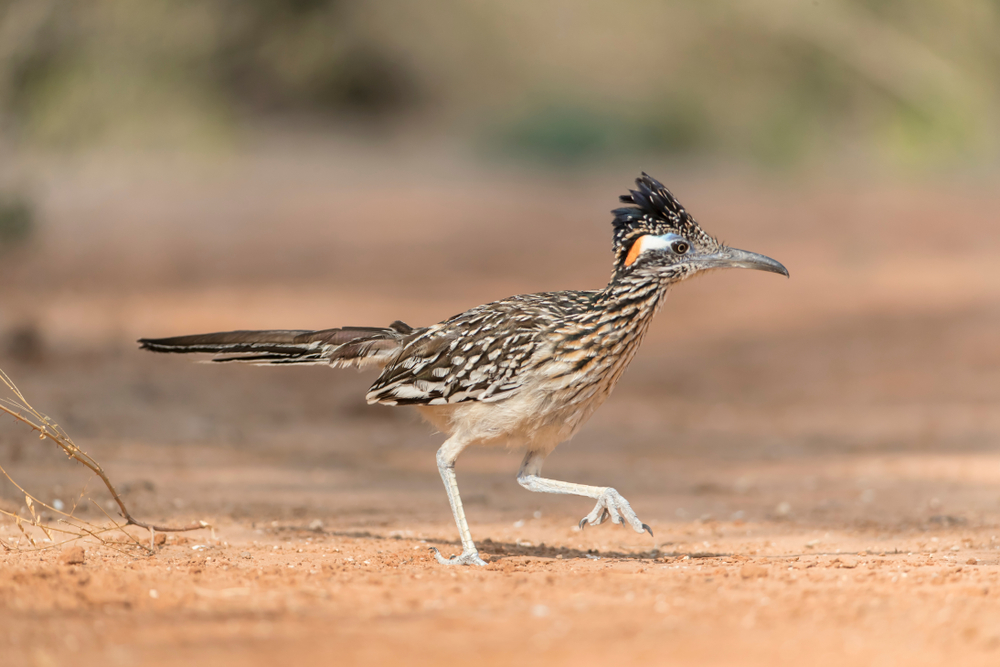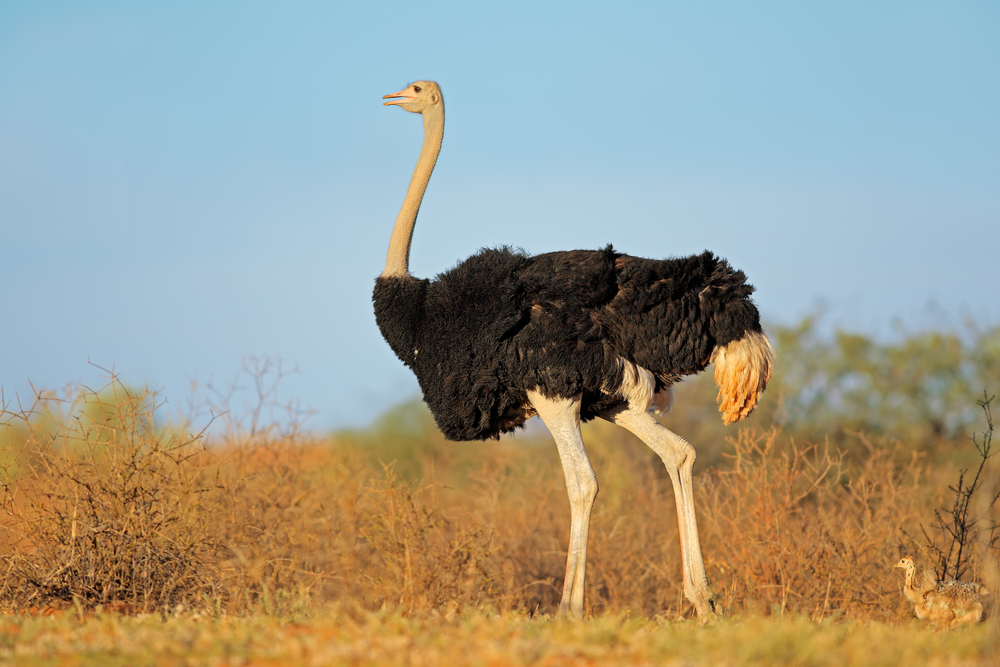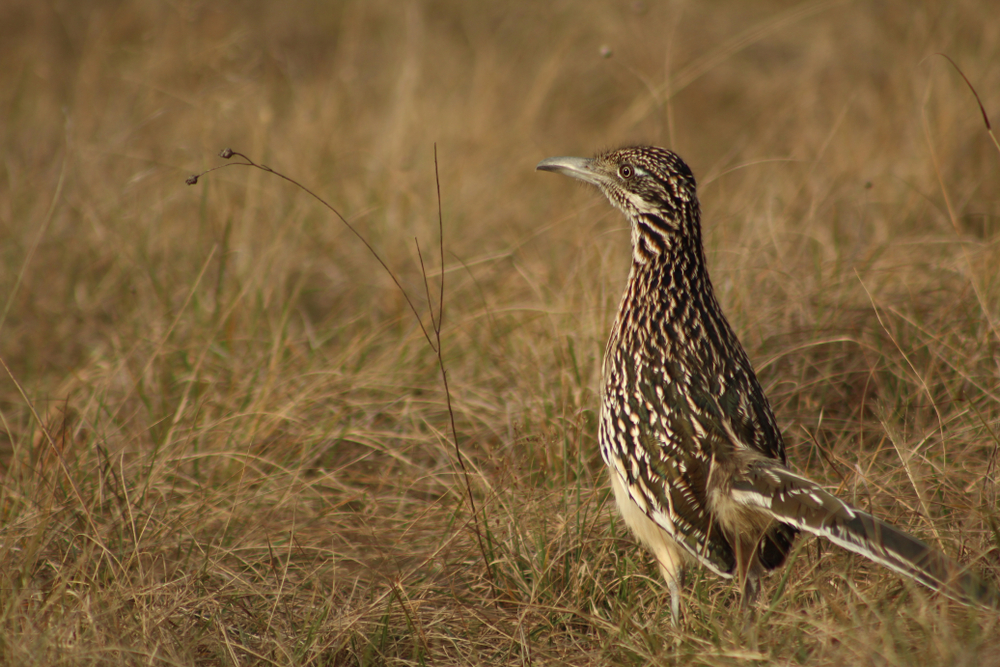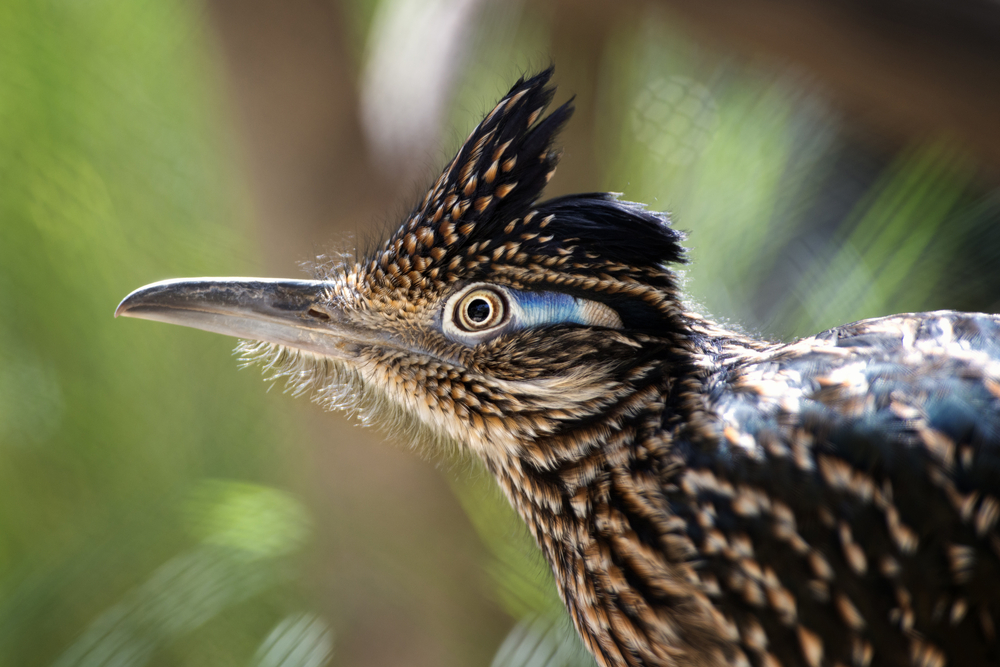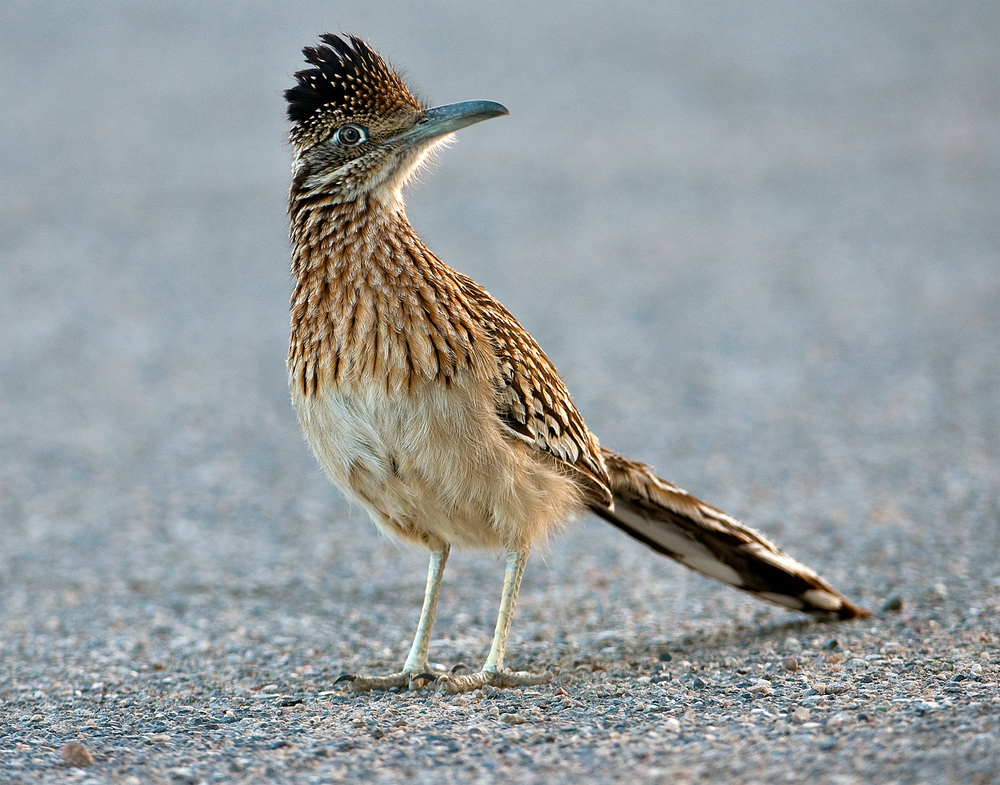About
The Road Runner, scientifically known as Geococcyx californianus, is a unique bird species belonging to the Animal Kingdom’s phylum Chordata and class Aves. It is a member of the Cuculidae family, which includes cuckoos and anis. Roadrunners are native to the deserts and arid regions of North and Central America.
These birds are known for their distinctive appearance and behavior. They have long legs, a slender body, and a distinctive crest on their heads. Roadrunners are fast runners, capable of reaching speeds of up to 20 miles per hour, which helps them evade predators and capture prey. Their plumage is predominantly brown and gray, providing camouflage in their arid habitats.
Roadrunners are primarily carnivorous, feeding on a diet of insects, small reptiles, rodents, birds, and occasionally fruits and seeds. They are opportunistic hunters, using their sharp beaks and agile movements to catch prey on the ground or in low vegetation. Roadrunners are also known for their distinctive vocalizations, including a series of cooing and clucking sounds.
Conservation Concerns
The Road Runner population currently faces few significant conservation concerns. Their adaptability to a range of habitats and ability to thrive in arid environments contribute to their stable population status. However, like many other bird species, Road Runners may face threats from habitat loss and fragmentation due to human development, climate change, and predation by introduced species.
Physical Characteristics
The Road Runner (Geococcyx californianus), also known as the Greater Roadrunner, is a long-legged bird in the cuckoo family, native to the deserts and shrubby landscapes of the Southwestern United States and Mexico. Famous for its running ability, the roadrunner is an iconic symbol of the American Southwest, celebrated in folklore and popular culture. Here’s a detailed look at the physical characteristics of the roadrunner:
Size
- Body Length: Roadrunners typically measure between 20 to 24 inches (50 to 61 centimeters) in length, from the tip of their beak to the end of their tail.
- Weight: They weigh between 7.5 to 19 ounces (212 to 538 grams), with slight variations depending on their habitat and diet.
Physical Characteristics
- Body Shape: Roadrunners have slender, streamlined bodies with strong, long legs that enable them to run at speeds of up to 20 mph (32 km/h) to escape predators and catch prey. Their body is adapted for ground foraging, with a posture that leans forward.
- Feathers and Coloration: The bird’s plumage is predominantly brown and white with streaks and spots, providing camouflage against the desert landscape. The roadrunner has a distinctive crest of feathers on its head, which can be raised or lowered.
- Beak: The beak is long, strong, and slightly curved downward, adapted for hunting a variety of prey, including insects, lizards, and small mammals.
- Eyes: Roadrunners have bright yellow or orange eyes, with a protective third eyelid, which helps keep their eyes moist and free from dust while maintaining visibility.
- Tail: The tail is long and broad, with black and white stripes, used for steering while running and for communication through various tail movements and positions.
- Legs and Feet: Their legs are strong and equipped with four toes, two facing forward and two backward, allowing for quick, agile movements. The zygodactyl foot arrangement aids in balance and maneuverability at high speeds.
Behavior and Adaptations
- Diet: Roadrunners are carnivorous, with a diet that includes insects, spiders, scorpions, mice, small birds, and reptiles, including rattlesnakes, which they kill with swift pecks to the head.
- Hunting and Feeding Behavior: They are opportunistic feeders, hunting on the ground with sudden bursts of speed to catch prey. Roadrunners have been observed using their tails to corner lizards and other fast-moving prey.
- Vocalizations: Their call is a series of cooing and clucking sounds, which is often amplified by an inflated throat.
- Nesting: Roadrunners build nests in low bushes or cacti, where they lay 2 to 6 eggs. Both parents share incubation duties and care for the young.
The roadrunner’s unique adaptations for life in arid environments, including its ability to run at high speeds, its diverse diet, and its distinctive physical characteristics, make it a fascinating subject of study and a beloved symbol of the American Southwest.
Reproduction
The reproductive cycle of the roadrunner, known for its quick movements and distinctive appearance, is adapted to its desert habitat and the challenges it faces. Here’s an overview:
Sexual Maturity: Roadrunners typically reach sexual maturity at around one year of age, although this can vary slightly depending on factors like food availability and environmental conditions.
Breeding Season: The breeding season for roadrunners usually occurs in the spring, from March to June, coinciding with the peak availability of food and favorable weather conditions in their desert habitat.
Courtship and Mate Selection: During the breeding season, male roadrunners engage in elaborate courtship displays to attract females. These displays may include vocalizations, wing-fluttering, and presenting nesting materials to the female.
Nesting and Egg-laying: Once a pair forms, the female roadrunner selects a suitable nest site, often in low shrubs or cacti, where she constructs a shallow nest lined with grasses, leaves, and feathers. She typically lays a clutch of 3 to 6 eggs, although clutch size can vary based on factors like habitat quality and food availability.
Incubation: Both the male and female roadrunners take turns incubating the eggs, with each partner incubating for periods ranging from several hours to a few days. Incubation lasts approximately 18 to 20 days, during which time the parents must carefully regulate the temperature and humidity of the nest.
Hatching and Chick Development: After the incubation period, the eggs hatch, and the parents work together to feed and care for the helpless chicks. Young roadrunners grow rapidly and develop their distinctive markings and behaviors within a few weeks of hatching.
Fledging and Independence: Roadrunner chicks fledge from the nest at around 18 to 21 days old but may continue to depend on their parents for food and protection for several weeks afterward. As they grow more independent, they learn essential hunting and survival skills from their parents before eventually dispersing to establish their territories.
Reproductive Success and Population Dynamics: The reproductive success of roadrunners depends on factors such as habitat quality, prey availability, and predation pressure. In healthy populations, roadrunners can produce multiple broods in a single breeding season, contributing to population stability and resilience.
Understanding the reproductive cycle of roadrunners is crucial for conserving these iconic desert birds and their unique ecosystems. Conservation efforts focused on preserving their habitat, managing human impacts, and reducing threats from predators and habitat loss can help ensure the long-term survival of roadrunner populations.
Lifespan
The Road Runner (Geococcyx californianus) is a distinctive bird species found in the deserts and arid regions of the southwestern United States and Mexico. Known for its iconic appearance and remarkable speed, the Road Runner is a member of the cuckoo family and is renowned for its ability to outpace predators, including snakes, birds of prey, and mammals. These birds play important ecological roles in their arid habitats, controlling insect populations and serving as prey for various predators.
Lifespan in the Wild: In the wild, Road Runners typically have a lifespan ranging from 7 to 8 years, although some individuals may live longer under favorable conditions. Their lifespan is influenced by various factors, including predation, habitat quality, food availability, and environmental stressors. Road Runners face natural threats such as predation by snakes, birds of prey, and mammals, which target them as prey. Additionally, habitat loss and fragmentation due to urbanization, agriculture, and development can negatively impact Road Runner populations by reducing available habitat, limiting foraging opportunities, and increasing human-wildlife conflicts.
Lifespan in Captivity: In captivity, Road Runners can have longer lifespans compared to their wild counterparts. When kept in wildlife rehabilitation centers, aviaries, or zoological facilities, where they receive regular food, protection from predators, and suitable habitat conditions, Road Runners can live up to 10 to 12 years or even longer. The absence of natural threats and access to consistent food, shelter, and medical care contribute to their extended lifespans in captivity.
Threats to the Road Runner:
- Predation: Road Runners are preyed upon by various predators in their natural habitat, including snakes, birds of prey (such as hawks and owls), and mammals (such as coyotes and foxes). These predators target Road Runners as a food source, relying on their speed and agility to capture them. Predation pressure can influence Road Runner behavior, habitat use, and reproductive success, affecting population dynamics and survival rates.
- Habitat Loss and Fragmentation: Habitat loss and fragmentation due to human activities, such as urbanization, agriculture, and development, pose significant threats to Road Runner populations by reducing available habitat, disrupting nesting sites, and limiting foraging opportunities. Fragmentation of natural habitats can isolate Road Runner populations, increase vulnerability to predation and environmental stressors, and hinder dispersal and gene flow among populations.
- Human-Wildlife Conflict: Road Runners may face conflicts with humans in urban and suburban areas, where they encounter hazards such as domestic pets, vehicles, and anthropogenic structures. Collisions with vehicles on roads and highways pose risks to Road Runners, leading to injuries or fatalities. Additionally, interactions with domestic cats and dogs can result in predation or harassment, further impacting Road Runner populations in human-dominated landscapes.
- Climate Change: Climate change and associated environmental stressors, such as temperature extremes, drought, and habitat degradation, can affect Road Runner populations by altering habitat suitability, food availability, and reproductive success. Changes in precipitation patterns and habitat quality can impact vegetation structure and insect abundance, influencing Road Runner foraging behavior and survival rates in arid ecosystems.
Conservation efforts focused on habitat preservation, habitat restoration, predator management, road ecology, public education, and community engagement are essential for mitigating these threats and ensuring the long-term survival of Road Runner populations in their native habitats. Collaboration among government agencies, conservation organizations, landowners, and local communities is critical for implementing effective conservation measures and promoting coexistence between humans and Road Runners in shared landscapes.
Eating Habits
The Road Runner (Geococcyx californianus) is a distinctive bird species known for its remarkable speed and unique adaptations. Found primarily in the deserts and arid regions of southwestern North America, the Road Runner has fascinating eating habits that contribute to its survival in harsh environments.
Diet: Road Runners are opportunistic carnivores with a diverse diet that includes insects, small reptiles, rodents, birds, eggs, and occasionally fruits and seeds. Their diet may vary depending on factors such as habitat, season, and prey availability.
Hunting Behavior: Road Runners are adept predators known for their swift running and agile maneuvering. They use their powerful legs and long, pointed bills to capture prey. Unlike other birds of prey that rely on soaring or perching to hunt, Road Runners primarily hunt on the ground, using their speed and stealth to pursue and catch prey.
Foraging Strategy: Road Runners employ a range of foraging strategies to obtain food. They are active hunters that patrol their territories in search of prey, utilizing their keen eyesight and excellent camouflage to spot potential targets. They may also employ ambush tactics, hiding behind vegetation or rocks before darting out to catch unsuspecting prey.
Prey Selection: Road Runners feed on a wide variety of prey, including insects such as grasshoppers, beetles, and caterpillars, as well as small lizards, snakes, birds, and mammals. They are known to target nestlings and eggs of other bird species, using their sharp bills to break open eggs or dispatch small prey.
Feeding Behavior: Once a Road Runner captures prey, it typically consumes it whole or tears it into smaller pieces using its bill. They may swallow small prey items whole, while larger prey may be dismembered and consumed over multiple feedings. Road Runners are known to cache excess food, storing it in crevices or under rocks for later consumption.
Nutritional Requirements: Road Runners require a diet rich in protein and other essential nutrients to support their high-energy lifestyle. Their ability to consume a wide variety of prey allows them to adapt to fluctuations in food availability and maintain their nutritional needs in challenging desert environments.
Interactions with Other Species: Road Runners play an important role in desert ecosystems as both predators and prey. They help control populations of insects and small vertebrates, contributing to ecosystem balance. Additionally, they may serve as prey for larger predators such as raptors, snakes, and mammals.
Conservation Status: The Road Runner is not considered threatened or endangered, and its populations are generally stable across its range. However, habitat loss, fragmentation, and human disturbance pose potential threats to local populations. Conservation efforts focused on habitat preservation and minimizing human impact are essential for ensuring the continued survival of Road Runner populations.
Uniqueness
The Road Runner (Geococcyx californianus) is a distinctive bird species known for its remarkable speed, agility, and iconic appearance. Here are some key aspects that make the Road Runner unique:
Physical Characteristics: Road Runners are medium-sized birds with long legs, a long tail, and a slender body. They have a distinctive crest of feathers on their head that they can raise or lower depending on their mood. Their plumage is predominantly brown and gray, providing excellent camouflage in their arid desert habitats.
Running Speed: Road Runners are incredibly fast runners, capable of sprinting at speeds of up to 20 miles per hour (32 kilometers per hour). They use their powerful legs and aerodynamic bodies to outrun predators such as coyotes, snakes, and birds of prey. Despite their name, Road Runners are also skilled fliers and can take to the air when necessary.
Dietary Habits: Road Runners are opportunistic omnivores with a varied diet that includes insects, spiders, small reptiles, rodents, birds, fruits, seeds, and even carrion. They are skilled hunters and foragers, using their sharp beaks and keen eyesight to locate and capture prey on the ground and in the air.
Unique Hunting Techniques: Road Runners employ a variety of hunting techniques to catch prey. They may chase down prey on foot, pouncing on it with their sharp beak and strong legs. They are also known to use their wings and tail feathers to create shade and distract prey, making it easier to capture.
Desert Adaptations: Road Runners are well-adapted to their desert habitats, where they face extreme temperatures and limited water sources. They have specialized salt glands that allow them to excrete excess salt from their bodies, helping them conserve water in arid environments. They are also capable of regulating their body temperature by panting and seeking shade during the hottest parts of the day.
Mating and Reproduction: Road Runners are monogamous birds that form pair bonds with a single mate. They build their nests in low shrubs or cacti, using twigs, leaves, and other plant materials to construct a cup-shaped nest. Females lay a clutch of 3 to 6 eggs, which they incubate for about 20 days. Both parents share in the responsibility of incubating the eggs and caring for the young.
Cultural Significance: Road Runners have cultural significance in Native American folklore and mythology, where they are often portrayed as clever and resourceful animals. They are also popular characters in cartoons and literature, where they are depicted as quick-witted and elusive creatures.
Road Runners’ unique combination of speed, agility, and adaptations for desert life make them fascinating and iconic inhabitants of the American Southwest. Studying and conserving these birds can provide valuable insights into the ecology and conservation of arid ecosystems.
Related Family Species
Sources
- Burnie, David & Wilson, Don, Animal, Smithsonian Institute, Washington DC.
- Hickman et al, Integrated Principle of Zoology, McGraw Hill, Boston.
- Paragon, The Ultimate Guide to Wildlife in North America, Atlantic Publishing, UK.



































































